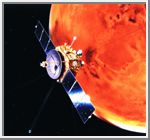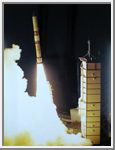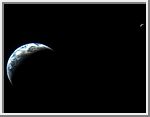
Japan Mars Orbiter
Courtesy of NASA's National Space Science Data Center
Table of Contents
Launch Date/Time: 1998-07-03 at 18:12:00 UTC
On-orbit dry mass: 258.00 kg
Description
The arrival of Nozomi at Mars has been delayed four years from its originally scheduled rendezvous in 1999 in order to conserve fuel. The spacecraft used more propellant than planned in a course correction maneuver on 21 December 1998 after the 20 December Earth flyby left the craft with "insufficient acceleration". The spacecraft will continue in a heliocentric orbit until it encounters Mars in December of 2003.
Nozomi (Japanese for Hope and known before launch as Planet-B) is a Mars orbiting aeronomy mission designed to study the martian upper atmosphere and its interaction with the solar wind and to develop technologies for use in future planetary missions. Specifically, instruments on the spacecraft will measure the structure, composition and dynamics of the ionosphere, aeronomy effects of the solar wind, the escape of atmospheric constituents, the intrinsic magnetic field, the penetration of the solar-wind magnetic field, the structure of the magnetosphere, and dust in the upper atmosphere and in orbit around Mars. The mission will also be returning images of Mars' surface.
Spacecraft and Subsystems
The Nozomi orbiter is a 0.58 meter high, 1.6 meter square prism with truncated corners. Extending out from two opposite sides are solar panel wings containing silicon solar cells which provide power to the spacecraft directly or via Ni-MH (nickel metal hydride) batteries. On the top surface is a dish antenna, and a propulsion unit protrudes from the bottom. A five meter deployable mast and a 1 meter boom extend from the sides, along with two pairs of thin wire antennas which measure 50 m tip to tip. Other instruments are also arranged along the sides of the spacecraft. Spacecraft communications are via X-band at 8410.93 MHz and S-band at 2293.89 MHz. The 14 instruments carried on Nozomi are an imaging camera, neutral mass spectrometer, dust counter, thermal plasma analyzer, magnetometer, electron and ion spectrum analyzers, ion mass spectrograph, high energy particles experiment, VUV imaging spectrometer, sounder and plasma wave detector, LF wave analyzer, electron temperature probe, and a UV scanner. The total mass budgeted for the science instruments is 33 kg. Radio science experiments will also be possible using the existing radio equipment and an ultrastable oscillator. The total mass of Nozomi at launch including 282 kg of propellant was 540 kg.
Mission Profile
After launch on an M-V-3 launch vehicle Nozomi was put into an elliptical geocentric parking orbit with a perigee of 340 km and an apogee of 400,000 km. The spacecraft used a lunar swingby on 24 September and another on 18 December, 1998 to increase the apogee of its orbit. It swung by Earth on 20 December at a perigee of about 1000 km. The gravitational assist from the swingby coupled with a 7 minute burn of the bipropellant engine put Nozomi into an escape trajectory towards Mars. It was scheduled to arrive at Mars on 11 October 1999 at 7:45:14 UT, but the Earth swingby left the spacecraft with insufficient acceleration and two course correction burns on 21 December used more propellant than planned, leaving the spacecraft short of fuel. The new plan is for Nozomi to remain in heliocentric orbit for an additional four years and encounter Mars at a slower relative velocity in December 2003. Nozomi will be inserted into a highly eccentric Mars orbit with a periapsis 300 km above the surface, an apoapsis of 15 Mars radii, and an inclination of 170 degrees with respect to the ecliptic plane. Shortly after insertion the mast and antennas will be deployed. The periapsis will then be lowered to 150 km, the orbital period will be about 38.5 hours. The spacecraft will be spin stabilized at 7.5 RPM with its spin axis (and the dish antenna) pointed towards Earth. The periapsis portion of the orbit will allow in-situ measurements of the thermosphere and lower exosphere and remote sensing of the lower atmosphere and surface. The more distant parts of the orbit will allow study of the ions and neutral gas escaping from Mars and their interactions with the solar wind. The nominal mission is planned for one martian year (approximately two Earth years). An extended mission may allow operation of the mission for three to five years. The spacecraft will also point its cameras at the martian moons Phobos and Deimos. The total mission cost of Nozomi is estimated at $848 million.
 Nozomi Spacecraft
Nozomi Spacecraft
This artist's conception of Nozomi shows the Spacecraft in
orbit around the red planet with its instrument masts fully deployed.
Nozomi is a Mars orbiting
aeronomy mission designed to study the martian upper atmosphere and its interaction with
the solar wind and to develop technologies for use in future planetary missions.
(Courtesy NASA/NSSDC)
 Launch of the Nozomi Spacecraft
Launch of the Nozomi Spacecraft
The Nozomi (Japanese for Hope and known before launch as Planet-B) was launched on 3 July
1998. The arrival of Nozomi at Mars was delayed four years from its originally scheduled
rendezvous in 1999 in order to conserve fuel. The spacecraft used more propellant than
planned in a course correction maneuver on 21 December 1998 after the 20 December Earth
flyby left the craft with "insufficient acceleration". The spacecraft will
continue in a heliocentric orbit until it encounters Mars in December of 2003.
(Courtesy NASA/NSSDC)
 The Earth and Moon
The Earth and Moon
This image of the Earth and Moon
was the first picture taken by the Nozomi camera.
(Courtesy NASA/KSC)

 Space History
Space History